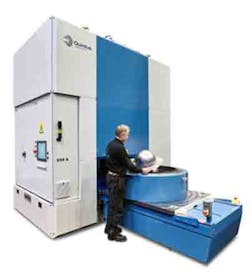Trestad Expanding Aerospace Capabilities with Quintus System
Trestad Laser AB, a subcontractor for formed metal components to GKN Aerospace and Siemens Industrial Turbomachinery, among others, ordered a new Quintus Technologies high-pressure fluid cell press for its operation in Trollhättan, Sweden. The investment is part of Trestad’s strategy to expand its metal-forming capabilities, in line with its laser cutting, welding, machining, and milling operations.
“We started out with welding and shaping, and the business has been focused on laser for years, but our assessment is that demand for shaped details will increase,” explained Per Andersson, who runs the business together with his three brothers. “That is why we have chosen to invest in modern, high-pressure equipment from Quintus. Our customers often demand complex and unique components made of materials that are hard to form, in relatively short series, and with high demand for short delivery times. The Quintus technology is well suited to meet those requirements.”
The QFM 1.1-800 Quintus fluid cell press applies 8,000 mt of pressure over a forming area of 1,100 mm (43 inches). The press will be put into operation in early summer. The Quintus process requires only one rigid tool half; the other tool half is replaced by a flexible rubber diaphragm under uniform hydrostatic pressure. This design reduces tooling costs and reduces the time needed for tool production.
“The decision to invest in a Quintus press really takes us back to our roots,” stated Trestad Laser founder Jan Andersson. “Several years ago, I took over the Quintus press operations from Volvo Flygmotor, which now is GKN Aerospace, and continued the business within Trestad Svets, today Siemens Industrial Turbomachinery.
“The investment also allows us to certify the company according to AS9100, the international standard which the aviation industry requires from its subcontractors,” he continued. “Our assessment is that the certification will have several positive side effects in other areas of our business.”

